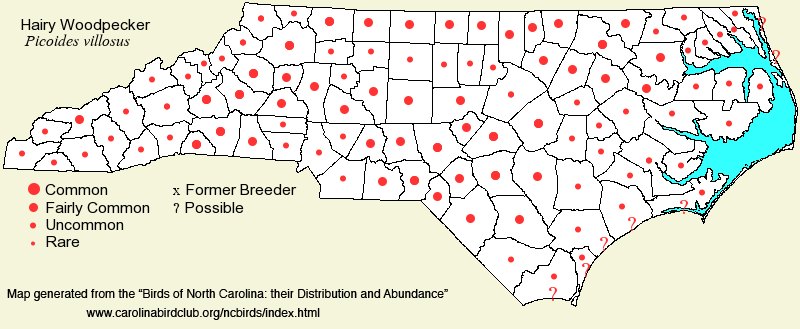 |  |
|
Hairy Woodpecker - Dryobates villosus PICIDAE Members: | Search Common: Search Scientific: |
|
|
|||||||
| General Comments | The "big brother" or "big cousin" of the Downy Woodpecker, the Hairy Woodpecker is often found with the Downy and can often be confused with it. Though it is much less common than the Downy, it is a rather noisy bird and is more conspicuous where both occur. The Hairy is essentially nonmigratory, and it uses the same habitats as the Downy, though it favors larger trees and is less likely to occur in middle-aged stands or residential areas. Favored habitats are extensive hardwood or mixed forests, both in uplands and in bottomlands/swamps. Unlike the Downy, but like many of the larger woodpeckers, Hairies often forage at recently burned or diseased areas, or in beaver ponds, to feed heavily at dead trees. It occasionally can be found in mixed-species flocks in winter but is not a regular member of these groups. Populations across the state apparently have shown small declines, mostly owing to fragmentation of extensive hardwood and mixed forests. | ||||||
| Breeding Status | Breeder | ||||||
| NC BRC List | Definitive | ||||||
| State Status | |||||||
| U.S. Status | |||||||
| State Rank | S4 | ||||||
| Global Rank | G5 | ||||||
| Coastal Plain | Permanent resident; essentially nonmigratory. Uncommon to fairly common in the inner portions of the region, being most numerous in floodplains of larger rivers -- e.g., fairly common along the Roanoke River. Uncommon in the Tidewater areas, and rare to locally absent on barrier islands, such as Hatteras Island (where mostly a rare visitor). Peak counts: ? | ||||||
| Piedmont | Permanent resident; essentially nonmigratory. Generally uncommon to fairly common, and reasonably widespread; most numerous in extensive floodplain forests. Considered fairly common across most of the region a few decades ago, but now uncommon in many places. Peak counts: ? | ||||||
| Mountains | Permanent resident, essentially nonmigratory. Generally uncommon, but widespread, over the entire region. Less numerous above 4,500 feet, but it does occur as a breeder, in small numbers even to 6,000 feet. However, in the cooler months, it generally abandons areas above about 5,000 feet. Peak counts: ? | ||||||
| Finding Tips |
This is a very widespread species, and is not local. Try birding various state parks, refuges, or other protected sites with extensive and/or mature hardwood forests. You almost always hear one before you see it, as they are noisy birds; however, you may have trouble seeing a calling bird, though all woodpeckers readily come in to taped calls. Be judicious in the use of taped calls in conservation areas. *** | ||||||
| Attribution | LeGrand[2023-03-22], LeGrand[2012-07-14], LeGrand[2011-12-10] | ||||||
| NC Map Map depicts all counties with a report (transient or resident) for the species. | Click on county for list of all known species. |
| NC Breeding Season Map Map depicts assumed breeding season abundance for the species. |  |